Mickey Hansen
AP Music Theory 🎶
72 resourcesSee Units
A rhythm is determined by how long each note or rest (pauses) is played. You can write rhythms by stringing together notes, each of which has a specified time value.
Counting in Music
Have you ever tapped your toe to a song, or bobbed your head to the tune? You're feeling the beat. The beat is the most basic unit of time in a measure. Some notes can take up multiple beats, and others will take up only a portion of a beat.
The number of beats per measure depends on the time signature. The time signature not only determines how many beats there are per measure, but it also tells you which note value gets counted as one beat. For simplicity's sake, however, we'll just assume that a quarter note is one full beat for now.
Quarter Notes
Beats are important to know in music because they help us organize the rhythmical symbols. These are called quarter notes. Each quarter note has a value of 1 beat.
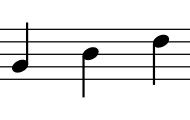
There is also a quarter note value of silence, called the quarter rest.
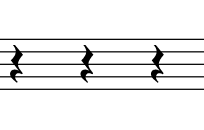
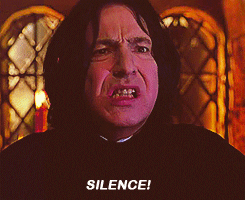
Subdividing Beats
If you divide a quarter note in half, you get an 8th note. This means there are two 8th notes for every quarter note beat.

Below are the symbols for 8th rests.
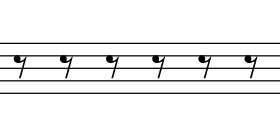
If you divide an 8th note in half, you get a 16th note.
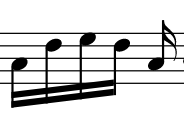
On the very right side of the above image is a lone 16th note. If you string 16th notes together, you can beam them, like with the four notes on the left side of the image. Add two 16th notes together and you get the value of an 8th note. Add four 16th notes together and you get a quarter note, or 1 beat.
Below is the symbol for a 16th note rest. In the image there are four 16th notes, which add up to 1 beat of rest.
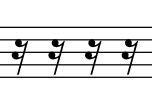
In addition to the 8ths and 16ths, there are also notes that get even small than that! While you probably won't see them on the AP test, you should know how they work. If you divide a 16th note in half, you get a 32nd note. 8, 16, 32, etc... What kind of note do you think is smaller than a 32nd? Yes, that mathematical pattern you just noticed continues with smaller and smaller notes. 32nds break down into 64ths, which break down into 168ths, and even smaller in certain music.
But what if you don't want to keep dividing a beat in half? I might want to divide it into 3 or 5 or 7! It is possible to do that as well. If you want to divide a quarter note into 3, for example, you can write a series of three eighth-notes, but connect them with a 3 in brackets. This is called a triplet.
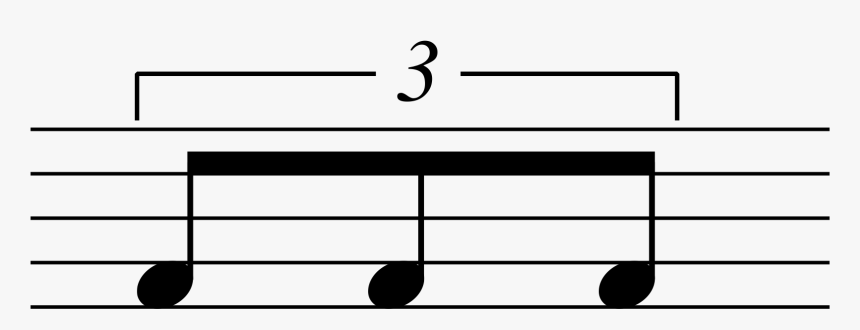
If you want to divide an eighth note into 3, you will do the same thing, but use double bar lines, and so on. You can also replace any of the notes in the bracket with other notes or rests. Suppose you want a triplet, but you want the first two beats to be a quarter rest, and the last beat to be two sixteenth notes. You can just put those two things in a bracket of 3, and it will be read as 2/3 of the beat has a quarter rest, and then there are two notes that last 1/6 of a beat each.
You use the same strategy to divide beats into 5, 6, 7, etc.! It's unlikely that you will see these in the AP exam, but if you do, you should remember how this pattern works.
Longer Notes
What if I want a note that takes up more than one beat? There are also half notes and whole notes. A half note takes up two beats. There is also a half rest, which indicates that there is a two-beat rest. A half note looks just like a quarter note, but with an open circle instead of a full circle.
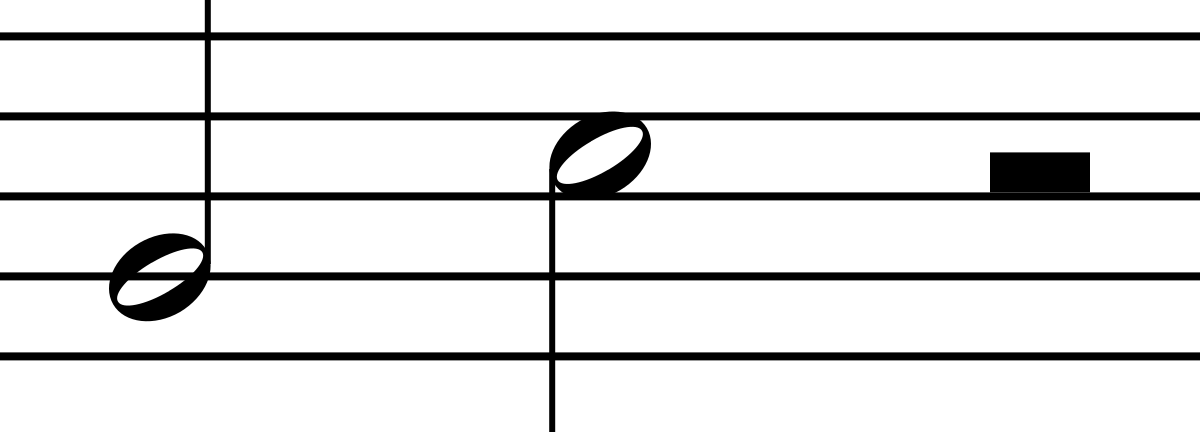
(image via Wikipedia)
Whole notes take up 4 beats, and they are just one open circle with no stem. There is also a corresponding whole rest, which takes up four beats.

(image via Wikipedia)
A lot of musicians have trouble differentiating a whole rest from a half rest at first. A fun way to remember is that a whole rest is like a "hole," which is why it is below the line. However, most of the times, when you're reading music, you will be able to differentiate the rests based on context.
Dots and Ties
There is another symbol that can be combined with these notes to make the value a bit longer. Introducing: the dot

When you see a dot after a note (not above a note, but to the side) this signifies that the note should be held an extra half value of what that note is. In the example below, a dotted quarter note will be held one and a half beats, to equal a quarter note plus an 8th note.
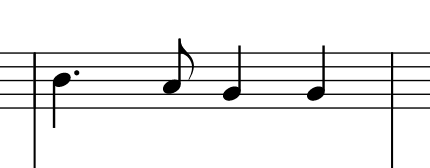
In the example below, the 8th note gets the dot (called a dotted 8th note) and the total value would be half a beat (8th note), plus a fourth of a beat (16th note), to make three-quarters of a beat. In other words, it would be an 8th plus a 16th in value.
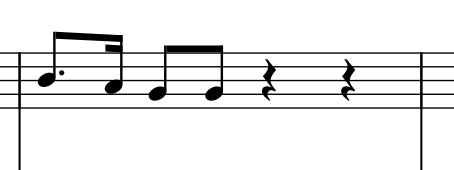
The first two notes above are beamed together to create one beat so that it is easier for the brain to organize. This is quite standard in music, and when you are writing your own music, you should also do this. For example, notice that the first two notes have values of 3/4 of a beat and 1/4 of a beat. As musicians, we generally have an idea in our heads about what this pattern should sound like, so it is easier to play.
Another way to organize music is by using the arch below, called a tie.
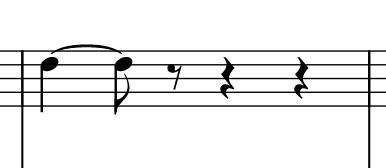
A tie simply ties the two notes together to create one longer note. In the case above, the quarter note is tied to an 8th note, which creates the same value as a dotted quarter note. It's just a different way to write the music, but there is no difference in the value. A tie will always connect two notes with the same pitch. Otherwise, it would be impossible to tie the notes together.
When you are looking at scores for classical music, you might notice two eighth notes tied together, and you might wonder: Why didn't they just write a quarter note? There are several reasons why the composer might have made this decision, including voice leading, which you'll learn about later. But another common reason is that it is conventional to make sure that the halfway mark of the measure is "visible."
For example, consider a measure with two beats, where you want the tune to be 8th note-quarter note-8th note. Writing the middle note as a quarter note covers the halfway mark of the measure, so instead, it would be conventional to write it as two eighth notes tied together.
You can also use a tie over a bar line. When musicians would like to have a value of a longer note but have come to the end of a measure, they can tie two notes together that add up to a longer note, and avoid over-stuffing a measure with too many beats.
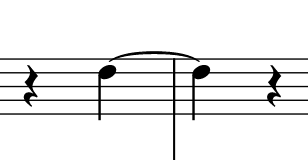
Be aware that a tie looks similar to a slur, since they both use an arch above or below the notes. A slur, however, uses different notes and is a type of articulation.
🦜Polly wants a progress tracker: Can you clap a steady quarter-note beat? Keep that going. Now start to clap a steady 8th note in the same tempo. Now can you switch to 16th notes?
More on Writing Music
There are a few conventions that you should follow when writing music. On the AP Music exam, you will have to write your own notes, so it is important to remember these. Just like writing letters, if you practice enough, these should come naturally over time.
The most important thing that you should remember is that stems will go upwards when the note is below the third line of the staff, and go downwards when the note is on or above the first line of the staff.
Next, the stems will take up 4 lines. So, if you write the note on the first space, the stem should take up the whole staff and touch the top line. All the stems should be approximately the same size, so if you write a note on the bottom line, the stem will reach halfway through the top space.
For dots, if the note is on a space, then write the dot in the space. If it is on a line, write the dot above the line.
Next, we'll talk about how we connect our eighth notes, 16th notes, triplets, etc. The first rule, as mentioned above, is to make sure to not cover the middle of the measure. You shouldn't have two connected notes that cross over the middle of the measure, and you also shouldn't have a note whose value extends through the middle of the measure.
However, this rule can be violated for time signatures with an odd number on top (3/4, 3/8, etc.). Then, it is acceptable to cover the middle of the measure, since the middle will be on a half beat.
Next, your connectors should usually make up a full beat (e.g. two 8th notes, four 16th notes, etc.). However, this might also depend on phrasing. If you want your sixteenth notes to be played such that every other note is staccato, you should probably pair them in twos.
You will get a feel most of these rules over time. if you are already a musician, you might already be used to reading music that follows these conventions. In that case, use your intuition. If something looks wrong or a little bit off, it probably is.
Browse Study Guides By Unit
🎵Unit 1 – Music Fundamentals I (Pitch, Major Scales and Key Signatures, Rhythm, Meter, and Expressive Elements)
🎶Unit 2 – Music Fundamentals II (Minor Scales and Key Signatures, Melody, Timbre, and Texture)
🎻Unit 3 – Music Fundamentals III (Triads and Seventh Chords)
🎹Unit 4 – Harmony and Voice Leading I (Chord Function, Cadence, and Phrase)
🎸Unit 5: Harmony and Voice Leading II: Chord Progressions and Predominant Function
🎺Unit 6 – Harmony and Voice Leading III (Embellishments, Motives, and Melodic Devices)
🎤Unit 7 – Harmony and Voice Leading IV (Secondary Function)
🎷Unit 8 – Modes & Form
🧐Exam Skills
📚Study Tools

Fiveable
Resources
© 2025 Fiveable Inc. All rights reserved.